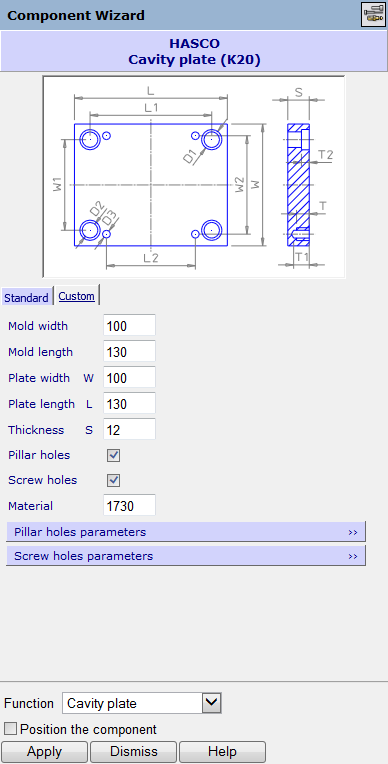Use the options on the Custom tab to change the standard dimensions:

Use the options like Plate width, Plate Length and Thickness to change the dimensions. The exact parameters that are displayed in the Custom tab reflect the type of component you are defining.
Material - Select the International Standard number for the material to be used.
Click the coloured bar to reveal the boxes:


Specify the parameters, and then click the coloured bar again to hide the boxes.
Function — The option you select specifies which component you intend to position the component on. Either select an option from the drop-down list or use the default option (Selected on model) to pick the component in the model.
Position the component — Select this option and click Apply on the browser page to add the object to the assembly. You can then position it using the following technique from Assembly modelling.
- Select an existing component. Valid attachments are now visible on the new component.
- Click an attachment on the new component. Valid attachments on the existing component now become visible. There are two types of attachments on the existing component: plane and axis attachments.
Plane attachment — This is shown as an arrow. If you hold the cursor over this attachment, the attachment on the new component is aligned in the same plane as the existing attachment. When you click the mouse, the new component is placed at the cursor position and aligned with this plane attachment.
Axis attachment — This is shown as an arrow with a circle at the bottom. If you hold the cursor over this attachment, the attachment on the new component is fixed on the axis attachment. If you click the mouse anywhere on the screen and don't hover over another attachment, the new component is snapped onto this axis attachment.
- When a new component is added to the existing component, another one appears. Cancel the command by clicking
 on the Quick Access toolbar; the new component disappears.
on the Quick Access toolbar; the new component disappears.
The component is also registered as an assembly component. You can create further copies of this component or modify it using Assembly modelling techniques.
- Click Apply to create the component on the screen.